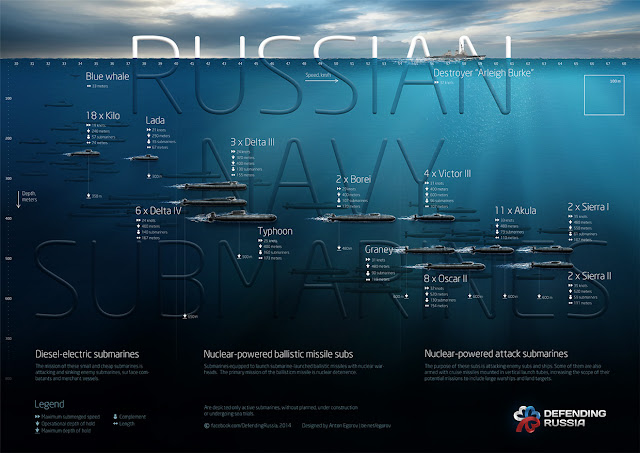For larger image click here (Courtesy Business Insider Australia) so you can see current Russian submarine diving depths. Diagram gives the speed, diving depth, crew and length of all of Russia's current submarines with images mostly to scale. This and other amazing Russian military diagrams were created by Anton Egorov of Military Infographics on Behance, Saint Petersburg, Russia.
---
The following is about Titanium (really
The NATO designations for most (or all?) Russian submarines that used Titanium alloy in their pressure hulls were: Mike, Alfa, Sierra and Typhoon. Despite its benefits, the high costs of Titanium submarine construction led to its abandonment as the Cold War ended.
Titanium alloys used for the pressure hull (or hulls) allow a major increase in depth, but other submarine systems need to be redesigned for extreme pressure as well. A submarine's test depth my be limited to 1,000 meters - the depth a Mike Komsomolets dived to in 1984 the only Titanium pressured hulled Mike class submarine built.
Seven Alfa class SSNs were commissioned between 1971 and 1981. One may have dived to 1,300 metres though continuous operation at such depths caused excessive stress for many submarine systems. For sustained operation at such a depth complete redesign of the plumbing and other inter-hull systems would have been required. The diving to 1,300 meters, caused damage to equipment, which in a few cycles (dives) would make an Alfa very unreliable. The 1,300 meter test may have been conducted just prior to decommissioning.Alfas were high speed test submarines never used operationally. Project Sapphire connected to the Alfa is worth a novel.
The 4 submarine Sierra class SSNs (commissioned 1987 to 1996) were successors to the Alfas. With only 4 Sierras built their cost may have been similar to the 3 hugely expensive, limited production, US Seawolfs (still operational). A 2013 report indicated two Sierra class might be modernised and recommissioned. The Sierras have a more sustainable Titanium pressure hulls than the Mike and Alfas with the Sierras diving 550 meters.
The 6 Typhoon SSBNs commissioned in the 1980s (none now operational - one used for SLBM tests) had two separate pressure hulls made of Titanium alloy. As Typhoons weighed 24,000 tonnes (surfaced) their pressure hulls may have consisted of 1,000s tonnes of Ti making Typhoons significant contributors to the eventual bankruptcy of the Soviet Union.
With Titanium pressure hulls making only small numbers of Alfas and Sierras possible the Russians decided to use lower cost steel in the SSN successors to the Sierras, the Akula SSNs. The Akulas are relatively successful with 15 completed. One steel hulled Yasen SSNhas been completed since it was laid down in 1993.
The cost and difficulty of working with Titanium alloy suggests Russia will not return to using it for submarine pressure hulls.
The cost and difficulty of working with Titanium alloy suggests Russia will not return to using it for submarine pressure hulls.
BACKGROUND
Titanium costs up to nine times more than steel and is technically difficult and expensive to manufacture into marine vessel hulls - so it has been generally avoided by the shipbuilding industry. Titanium needs a totally different manufacturing process; shipyard workers must be retrained; construction halls must be reconfigured; and bending and shaping of heavy plates of Titanium alloy are far more difficult compared to steel.
Arguments for Titanium alloy is that it can be built thin - making it even lighter. For maximum diving depth submarines could be constructed of welded steel many mm thick however this makes hull weight excessive. Many other heavy essentials need to be packed into a submarine including including reactors or diesels/batteries, fuel oil, crew spaces, weapons and electronics. Heavy hull weight also adversely effects buoyancy and manoeuvrability. If constructed in Titanium submarines have lighter weight for the same size and virtually no corrosion.
Specific factors which control the economics of joining/welding Titanium alloys may include:
- the need for extreme cleanliness and careful gas shielding to prevent harmful contamination during fusion welding,
- the high cost of available weld filler materials (approximately $40 per pound decades ago - much higher now) and
- the unavailability of an electrode for shielded-metal-arc welding (SMAW).
The difficulty of welding Japan's submarine steel (equivalent to HY-156/157) may involve similar challenges.
Up to the 1990s Russian Titanium for submarine technology was far in advance of the West's, requiring fewer passes to achieve welds. Non-weldable Titanium alloys of HY-175 and greater are possible.
"S" located information about Russia’s current Titanium alloy situation specifically concerning the VSMPO-AVISMA Corporation at http://www.vsmpo.ru/en . VSMPO-AVISMA used to make submarine Titanium alloy in former Soviet Union and is still the world leader in Titanium manufacturing. It is the major Titanium supplier to Airbus Industries and second largest supplier to Boeing.
VSMPO-AVISMA's export business is: Aircraft (35%) and Aircraft engines (12%). Customers include Airbus, Rolls Royce, Boeing, Pratt & Whitney, etc. VSMPO-AVISMA and Boeing co-developed new Titanium alloy (known as Ti-5553 used in the Boeing 787) and established a joint venture, Boeing Ural Manufacturing near VSMPO, Russia.
I'll write a future article about Chinese use of Titanium and also HY hull strengths of Chinese and Russian submarines.
Pete
